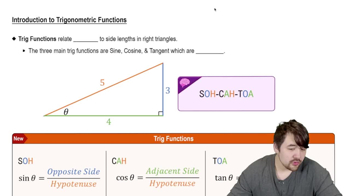Table of contents
- 0. Functions7h 52m
- Introduction to Functions16m
- Piecewise Functions10m
- Properties of Functions9m
- Common Functions1h 8m
- Transformations5m
- Combining Functions27m
- Exponent rules32m
- Exponential Functions28m
- Logarithmic Functions24m
- Properties of Logarithms34m
- Exponential & Logarithmic Equations35m
- Introduction to Trigonometric Functions38m
- Graphs of Trigonometric Functions44m
- Trigonometric Identities47m
- Inverse Trigonometric Functions48m
- 1. Limits and Continuity2h 2m
- 2. Intro to Derivatives1h 33m
- 3. Techniques of Differentiation3h 18m
- 4. Applications of Derivatives2h 38m
- 5. Graphical Applications of Derivatives6h 2m
- 6. Derivatives of Inverse, Exponential, & Logarithmic Functions2h 37m
- 7. Antiderivatives & Indefinite Integrals1h 26m
- 8. Definite Integrals4h 44m
- 9. Graphical Applications of Integrals2h 27m
- 10. Physics Applications of Integrals 2h 22m
1. Limits and Continuity
Finding Limits Algebraically
Problem 3.5.19
Textbook Question
Use Theorem 3.10 to evaluate the following limits.
lim x🠂2 (sin (x-2)) / (x2 - 4)
 Verified step by step guidance
Verified step by step guidance1
Theorem 3.10 refers to L'Hôpital's Rule, which is used to evaluate limits of indeterminate forms like 0/0 or ∞/∞. First, check if the given limit is in an indeterminate form by substituting x = 2 into the expression.
Substitute x = 2 into the expression: (sin(x-2)) / (x^2 - 4). This results in (sin(0)) / (2^2 - 4), which simplifies to 0/0, confirming the indeterminate form.
Since the limit is in the 0/0 indeterminate form, apply L'Hôpital's Rule. This involves taking the derivative of the numerator and the derivative of the denominator separately.
Differentiate the numerator: The derivative of sin(x-2) with respect to x is cos(x-2). Differentiate the denominator: The derivative of x^2 - 4 with respect to x is 2x.
Apply L'Hôpital's Rule by taking the limit of the new expression: lim x→2 (cos(x-2)) / (2x). Substitute x = 2 into this expression to evaluate the limit.
 Verified video answer for a similar problem:
Verified video answer for a similar problem:This video solution was recommended by our tutors as helpful for the problem above
Video duration:
3mPlay a video:
Was this helpful?
Key Concepts
Here are the essential concepts you must grasp in order to answer the question correctly.
Limits
Limits are fundamental in calculus, representing the value that a function approaches as the input approaches a certain point. In this context, evaluating the limit as x approaches 2 involves determining the behavior of the function (sin(x-2) / (x² - 4)) near that point, which may require simplification or application of limit laws.
Recommended video:

One-Sided Limits
Theorem 3.10 (L'Hôpital's Rule)
Theorem 3.10, commonly known as L'Hôpital's Rule, provides a method for evaluating limits that result in indeterminate forms like 0/0 or ∞/∞. It states that if such a form occurs, the limit of the ratio of two functions can be found by taking the derivative of the numerator and the derivative of the denominator, and then re-evaluating the limit.
Recommended video:

Fundamental Theorem of Calculus Part 1
Trigonometric Limits
Trigonometric limits often involve functions like sine and cosine, which can exhibit unique behaviors near certain points. In this case, the limit of sin(x-2) as x approaches 2 is crucial, as it simplifies the evaluation of the overall limit. Understanding the properties of trigonometric functions helps in resolving limits involving these functions effectively.
Recommended video:

Introduction to Trigonometric Functions

 5:21m
5:21mWatch next
Master Finding Limits by Direct Substitution with a bite sized video explanation from Callie
Start learningRelated Videos
Related Practice







